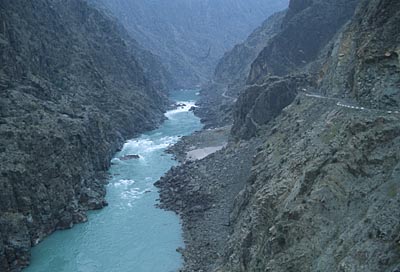 This
is a typical section of the KKH. It is two lanes, well paved, and cut
out of steep rock faces. It truly took some vision on the part of the
Pakistanis and Chinese to build this road. Much of the road is lined with
white concrete chunks that remind you were the road edge is, and serve
as guard rails if you have a lapse of attention. The Indus river has the
classic blue-green color of glacially fed streams. This
is a typical section of the KKH. It is two lanes, well paved, and cut
out of steep rock faces. It truly took some vision on the part of the
Pakistanis and Chinese to build this road. Much of the road is lined with
white concrete chunks that remind you were the road edge is, and serve
as guard rails if you have a lapse of attention. The Indus river has the
classic blue-green color of glacially fed streams. |
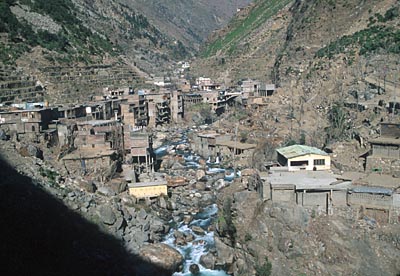 This
is a small town along the highway, set into a steep sided valley, with
concrete buildings and terraced fields in every possible place. A good
water supply makes this a lush little valley. This
is a small town along the highway, set into a steep sided valley, with
concrete buildings and terraced fields in every possible place. A good
water supply makes this a lush little valley. |
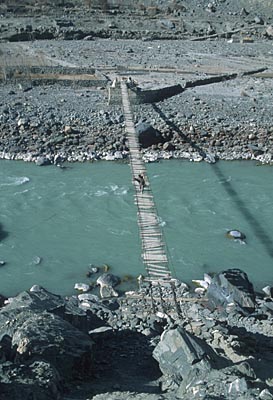 Crossing
the Indus is often a problem, and any bridge is a very valuable commodity,
even if it is in a little disrepair. I would have gone across here, but
we just did not have enough time... Crossing
the Indus is often a problem, and any bridge is a very valuable commodity,
even if it is in a little disrepair. I would have gone across here, but
we just did not have enough time... |
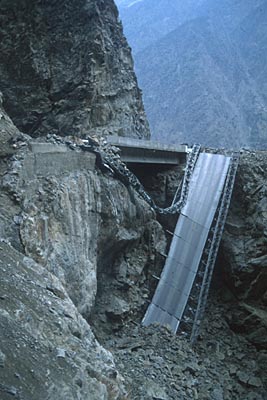 This
bridge was taken out in the spring of 2000. A large slab of cliff dropped
onto it during the rains. There is now a temporary concrete bridge here.
The Pakistanis work very hard to keep the road open and in good repair.
It is an economic windfall for the Northern part of Pakistan as well as
a real source of national pride. This
bridge was taken out in the spring of 2000. A large slab of cliff dropped
onto it during the rains. There is now a temporary concrete bridge here.
The Pakistanis work very hard to keep the road open and in good repair.
It is an economic windfall for the Northern part of Pakistan as well as
a real source of national pride. |
 This
is a view from the KKH. Lower down, the fields are green all year round.
The hand constructed terraces can be found everywhere. These allow agriculture
to flourish on the most unlikely slopes. This
is a view from the KKH. Lower down, the fields are green all year round.
The hand constructed terraces can be found everywhere. These allow agriculture
to flourish on the most unlikely slopes. |
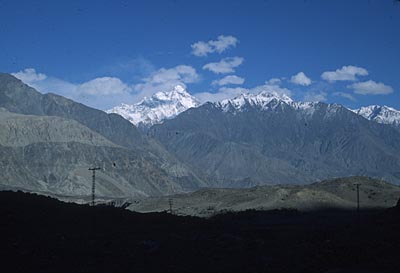 Along
the highway you can see many large rugged peaks hiding behind the lower
canyon walls. I asked Fazal what the name of this one was. He graciously
said "I proclaim this to be Mark Peak." Many of the mountains
in the Karakoram and Himalaya do not have names, and have never been summited. Along
the highway you can see many large rugged peaks hiding behind the lower
canyon walls. I asked Fazal what the name of this one was. He graciously
said "I proclaim this to be Mark Peak." Many of the mountains
in the Karakoram and Himalaya do not have names, and have never been summited. |
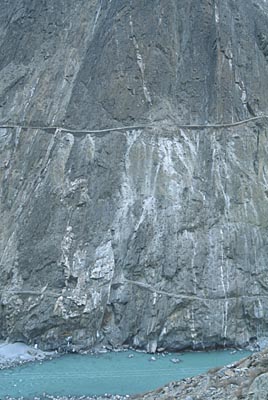 All
along the KKH you can see remnants of the original Silk Road. Many times
this was nothing more than a man high notch cut into a cliff. Here, bricks
were laid, and a road of sorts was pasted onto this cliff. We are all
very happy that the KKH is not so narrow and exposed. All
along the KKH you can see remnants of the original Silk Road. Many times
this was nothing more than a man high notch cut into a cliff. Here, bricks
were laid, and a road of sorts was pasted onto this cliff. We are all
very happy that the KKH is not so narrow and exposed. |
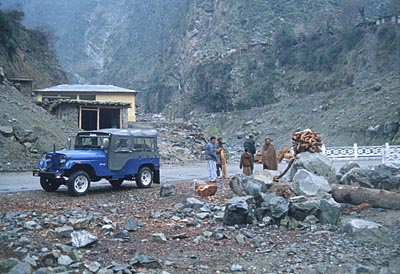 In
the territory of "Kohistan" ( the ungovernable region) is found
the best firewood. Heavy and dense, it is good for heat in the cold winter.
We stopped and purchased the pile on top of the rock, for 50 rupees, about
$.80. The sale involved lots of gupchupping and took about eight of the
locals to complete. They all want to help carry and load, it was quite
the event. In
the territory of "Kohistan" ( the ungovernable region) is found
the best firewood. Heavy and dense, it is good for heat in the cold winter.
We stopped and purchased the pile on top of the rock, for 50 rupees, about
$.80. The sale involved lots of gupchupping and took about eight of the
locals to complete. They all want to help carry and load, it was quite
the event. |
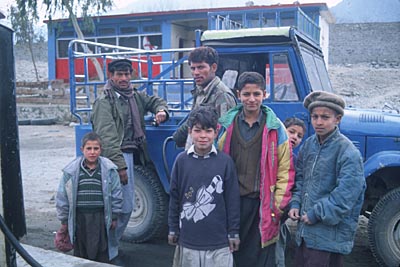 Getting
diesel gasoline is also a group effort. During the winter, there is not
much work to do in the fields, so people will do just about anything be
entertained. You can tell it is cold, because everyone has a coat or sweater
on. Most times, the natives did not wear any extra clothing. I would have
my long johns, wind pants and hat on! Getting
diesel gasoline is also a group effort. During the winter, there is not
much work to do in the fields, so people will do just about anything be
entertained. You can tell it is cold, because everyone has a coat or sweater
on. Most times, the natives did not wear any extra clothing. I would have
my long johns, wind pants and hat on! |
 This
is a typical section of the KKH. It is two lanes, well paved, and cut
out of steep rock faces. It truly took some vision on the part of the
Pakistanis and Chinese to build this road. Much of the road is lined with
white concrete chunks that remind you were the road edge is, and serve
as guard rails if you have a lapse of attention. The Indus river has the
classic blue-green color of glacially fed streams.
This
is a typical section of the KKH. It is two lanes, well paved, and cut
out of steep rock faces. It truly took some vision on the part of the
Pakistanis and Chinese to build this road. Much of the road is lined with
white concrete chunks that remind you were the road edge is, and serve
as guard rails if you have a lapse of attention. The Indus river has the
classic blue-green color of glacially fed streams. This
is a small town along the highway, set into a steep sided valley, with
concrete buildings and terraced fields in every possible place. A good
water supply makes this a lush little valley.
This
is a small town along the highway, set into a steep sided valley, with
concrete buildings and terraced fields in every possible place. A good
water supply makes this a lush little valley. Crossing
the Indus is often a problem, and any bridge is a very valuable commodity,
even if it is in a little disrepair. I would have gone across here, but
we just did not have enough time...
Crossing
the Indus is often a problem, and any bridge is a very valuable commodity,
even if it is in a little disrepair. I would have gone across here, but
we just did not have enough time... This
bridge was taken out in the spring of 2000. A large slab of cliff dropped
onto it during the rains. There is now a temporary concrete bridge here.
The Pakistanis work very hard to keep the road open and in good repair.
It is an economic windfall for the Northern part of Pakistan as well as
a real source of national pride.
This
bridge was taken out in the spring of 2000. A large slab of cliff dropped
onto it during the rains. There is now a temporary concrete bridge here.
The Pakistanis work very hard to keep the road open and in good repair.
It is an economic windfall for the Northern part of Pakistan as well as
a real source of national pride. This
is a view from the KKH. Lower down, the fields are green all year round.
The hand constructed terraces can be found everywhere. These allow agriculture
to flourish on the most unlikely slopes.
This
is a view from the KKH. Lower down, the fields are green all year round.
The hand constructed terraces can be found everywhere. These allow agriculture
to flourish on the most unlikely slopes. Along
the highway you can see many large rugged peaks hiding behind the lower
canyon walls. I asked Fazal what the name of this one was. He graciously
said "I proclaim this to be Mark Peak." Many of the mountains
in the Karakoram and Himalaya do not have names, and have never been summited.
Along
the highway you can see many large rugged peaks hiding behind the lower
canyon walls. I asked Fazal what the name of this one was. He graciously
said "I proclaim this to be Mark Peak." Many of the mountains
in the Karakoram and Himalaya do not have names, and have never been summited. All
along the KKH you can see remnants of the original Silk Road. Many times
this was nothing more than a man high notch cut into a cliff. Here, bricks
were laid, and a road of sorts was pasted onto this cliff. We are all
very happy that the KKH is not so narrow and exposed.
All
along the KKH you can see remnants of the original Silk Road. Many times
this was nothing more than a man high notch cut into a cliff. Here, bricks
were laid, and a road of sorts was pasted onto this cliff. We are all
very happy that the KKH is not so narrow and exposed. In
the territory of "Kohistan" ( the ungovernable region) is found
the best firewood. Heavy and dense, it is good for heat in the cold winter.
We stopped and purchased the pile on top of the rock, for 50 rupees, about
$.80. The sale involved lots of gupchupping and took about eight of the
locals to complete. They all want to help carry and load, it was quite
the event.
In
the territory of "Kohistan" ( the ungovernable region) is found
the best firewood. Heavy and dense, it is good for heat in the cold winter.
We stopped and purchased the pile on top of the rock, for 50 rupees, about
$.80. The sale involved lots of gupchupping and took about eight of the
locals to complete. They all want to help carry and load, it was quite
the event. Getting
diesel gasoline is also a group effort. During the winter, there is not
much work to do in the fields, so people will do just about anything be
entertained. You can tell it is cold, because everyone has a coat or sweater
on. Most times, the natives did not wear any extra clothing. I would have
my long johns, wind pants and hat on!
Getting
diesel gasoline is also a group effort. During the winter, there is not
much work to do in the fields, so people will do just about anything be
entertained. You can tell it is cold, because everyone has a coat or sweater
on. Most times, the natives did not wear any extra clothing. I would have
my long johns, wind pants and hat on!